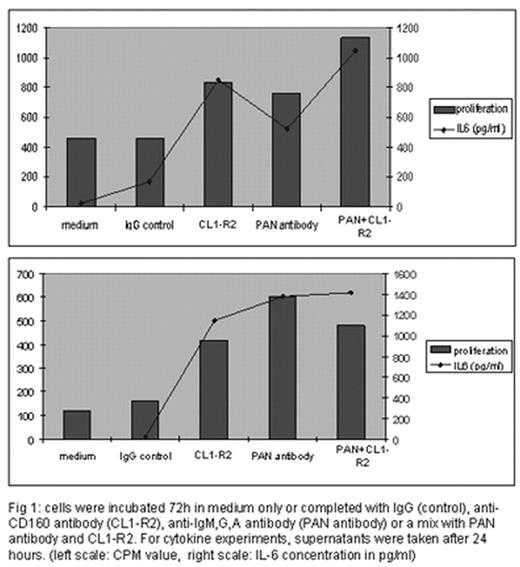Abstract
We have previously demonstrated the expression of the Natural Killer cell (NK) marker CD160 in CLL, which is not expressed by normal B cells1. CD160 is a cell surface molecule expressed by human and mouse circulating cytotoxic lymphocytes and exhibits a broad specificity for major histocompatibility complex (MHC) class Ia and Ib molecules 2,3,4. Triggering of CD160 on NK cells leads to cell proliferation and IL-6 production5. IL-6 is a pleiotropic cytokine produced by a variety of cell types, including lymphocytes6. IL-6 expression has been associated with the development of lymphomas7, while higher serum IL-6 levels correlated with shorter survival in CLL8. Without stimulation, CLL cells secreted low basal levels of INF-γ (100pg/ml) and even lower levels of IL-2, IL-4, IL-6, IL-10 and TNF-α (< 50pg/ml) (cytokine bead array, BD Bioscience). Incubation with CL1-R2, an anti-CD160 monoclonal antibody, led to an increase in IL-6 alone (up to 1500pg/ml), which was associated with significant cell proliferation (detected by 3H incorporation) - median 100%, range 50 to 400% (n = 13). Different patterns of response were seen, with all cases showing proliferation to CL1-R2 alone and with the positive control pan anti-immunoglobulin Ab (anti-Ig Ab). In some cases, there was marked synergy between CL1-R2 and anti-Ig Ab. We found that the MEC I and MEC II B-cell lines, derived from a patient with prolymphocytic progression of CLL (DSMZ Institut), express CD160 and show CL1-R2 enhanced proliferation (30 to 55% increase). However, MEC I and MEC II only unregulated IL-10 production (13 to 33% increase). Interestingly, proliferation of CD160Neg Sanchez EBV-immortalized B-cells was inhibited when these cells were incubated with CHO-CD160 transfectants. This inhibition was reversed with an anti-CD160 Ab or anti-MHC-class I W6/32 Ab. The CD160-MHC-I interaction plays a role in CLL biology. MAb engagement of CD160 leads to:
a direct proliferative signal;
CD160-triggered production of IL-6 and IL-6 mediated effects;
inhibition of a constitutive negative signal mediated via MHC-I molecules by their ligand CD160 (supported by the inhibition of the Sanchez cells by CD160 interaction with their MHC class I).
The CD160-MHC class I axis represents a new pathway in CLL biology offering new therapeutic targets. This work also suggests a role for targeting the IL-6/IL-6R system in CLL - for example, with humanized anti-IL6 R (Actemra), already used for Castleman’s disease and Rheumatoid Arthritis.
cells were incubated 72h in medium only or completed with IgG (control), anti-CD 160 antibody (CL1-R2), anti-IgM, G, A antibody (PAN antibody) or mix with PAN antibody and CL1-R2. For cytokine expriments, supernatants were taken after 24 hours. (left scale: CPM value, right scale: IL-6 concentration in pg/ml)
cells were incubated 72h in medium only or completed with IgG (control), anti-CD 160 antibody (CL1-R2), anti-IgM, G, A antibody (PAN antibody) or mix with PAN antibody and CL1-R2. For cytokine expriments, supernatants were taken after 24 hours. (left scale: CPM value, right scale: IL-6 concentration in pg/ml)
Author notes
Disclosure: No relevant conflicts of interest to declare.


